Alaska Fish & Wildlife News
June 2018
Prescribed Burn on the Delta Junction Bison Range
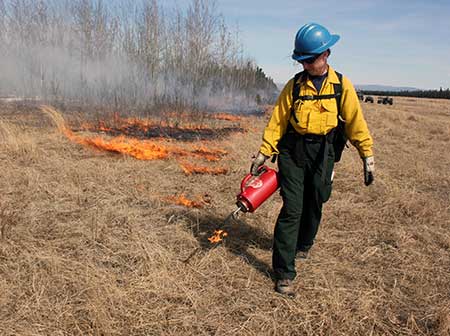
Hats turned on backwards and sunglasses on, Mary Jo Hill, Gabe Pease-Madore and Sue Rodman drove their ATV's into the Panoramic Fields of the Delta Junction Bison Range in early May to evaluate fuel moisture and site conditions for the upcoming planned prescribed fire. Taking place about two and a half weeks later than the 2017 burn, staff from ADF&G and State Forestry hoped that the recent winds and warm temperatures would have dried out the fields enough to ignite portions of the DJBR for continued habitat enhancement.
On April 22-23, 2017, staff from both state agencies and the BLM burned about 800 acres in the northern portion of the Panoramic Field Complex. Winter left early that year and the grasses readily carried fire. The result was good consumption of the grass mat which stimulated fresh regeneration of grass for bison. Additionally, crews burned several brush fields where aspen and willow had taken over places where grasses had grown in the past. This natural succession of the vegetation is common in many of the ‘panels’ across both the Panoramic and Gerstle field complexes.
Since the fields were originally cleared in the mid-1980s, managers of the bison range have had the continued challenge to maintain grasses for bison grazing. Mowing, tilling, planting, and prescribed fire are all tools employed then and now to promote grasses as the primary vegetative cover. Over time, some panels, or acreages of tilled land between tree rows, have grown in faster than range managers could keep up. In some of these panels, aspen trees have grown up to heights of 8-30 feet. Where the saplings are still of small diameter, Clint Cooper, wildlife biologist and manager of the bison range, has used a mower or brush hog to cut these trees back to short stobs.
As these panels within the field complexes have matured over time, bison range managers acknowledged that not all panels would serve the grazing needs of bison. Rather, moose and grouse also benefit from this mosaic cover type. While spruce forests dominate the landscape, past fires and range management activities have given way to variable aged aspen stands with substantial willow ingrowth. In order to maintain age diversity of the aspen, in past years, and again over the last winter of 2017-2018, staff from State Forestry have roller chopped aspen stands where trees are 25-30 feet tall with 3-5 inch diameters. With this mechanical operation, the trees are sheared off at the base by the bulldozer blade, and then cut into 18-inch segments when the glycol-weighted roller chopper drum rolls over the downed stems. Killing the aspen in this way sends a message to the common root system of this tree organism that new shoots should be sent up. By the following summer, hundreds of aspen stems cover the ground where their predecessors lay providing nutrients back to the soil. Resetting the successional advancement of these aspen stands in this way provides fresh new shoots of aspen for moose to browse where the older trees had grown out of their reach.
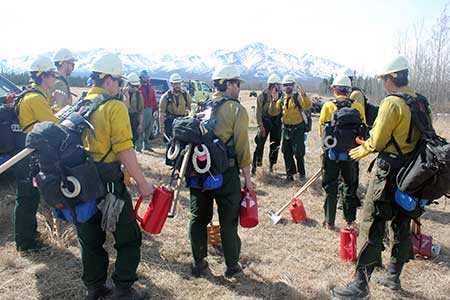
Walking through these panels of grass, mowed brush, and tall brush, we find many willow and aspen have been browsed by moose. The variety of plants here provide a nutritious and plentiful palette of food that is browsed only moderately by the moose. Hare browse is very common across this area. We can see many plants that have been sheared diagonally by their sharp front teeth about 16 inches from the ground. And we are surprised by a few sharp-tailed grouse that hastily flee as we approach.
The bison range manager spends many hours every year tilling, planting, fertilizing and mowing at the bison range, in order to produce as much high quality bison forage as possible. Annual crops such as oats and turnips are planted each year, and high quality perennial forage grasses such as Kentucky bluegrass are planted, fertilized, and maintained. This work is done in support of the 2012 Delta Bison Range Interim Management Plan. The plan directs ADF&G to ‘reduce bison conflicts with agriculture primarily by managing DJBR to attract bison away from agricultural lands…’ With one range manager and a set budget, Cooper’s time must be carefully scheduled to till, plant, and fertilize enough acres to keep the bison occupied before and during the barley harvest in the private agricultural fields to the north.
In the past, as willow and aspen saplings encroached into the cleared panels, prescribed fire was used to set back the invading woody species. However, times changed and new requirements were implemented for fire managers to conduct these operations. The use of fire was abandoned for a number of years on the bison range, and it was difficult for the range manager to keep up with the invading brush. When time allows, Cooper does mow regenerating aspen and willow. However, we are learning that the cost of mowing may be offset by prescribed fire. Determining factors include acreage burned per year, number of firefighters used to run the operation, and the extent of ‘mop-up’ needed to ensure that any smoldering piles of wood are extinguished before fire season starts in Delta Junction.
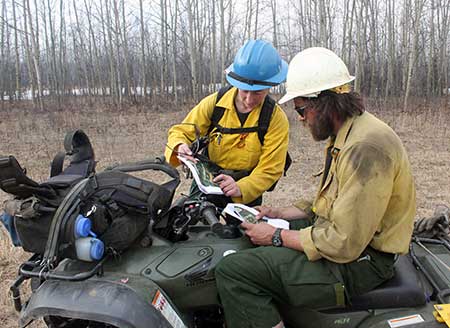
To comply with the standards set at the national level by the National Wildfire Coordinating Group, State Forestry and the Alaska Department of Fish & Game set out to reinstitute fire on the Delta Junction Bison Range in 2017. A prescribed fire burn plan was written and technically reviewed per these national standards. This effort also included compliance with the Department of Environmental Conservation’s Open Burn Approval permit. ADF&G must follow the State’s Air Quality Control Regulations and Enhanced Smoke Management Plan to implement prescribed fire. State Forestry is the agency lead for conducting the burns and provides qualified staff to run the operation.
Burning the Fields
Back in the fields on May 8th, 2018, Gabe, Mary Jo, and Sue spent several hours testing the fuel moisture of the fire’s carrier: grass. Between the tree rows, the wind swept up the silty soil into our teeth. The dryness of the site was only surface deep though, just under the leaves and dead grass, the soil was wet and stuck to our fingers as the snow had just melted a week prior. With leaves yet to unfurl from the trees, and this year’s fresh grass only a centimeter tall hiding under last year’s dead matt, the small herd of bison ahead of us were interested in finding fresh food. They looked back at us with mild curiosity, but then trotted away with their red calves and seemingly happy attitude this beautiful spring day.
With the weather forecast for the next few days promising warm temperatures, moderate humidity, and wind, the three agreed that ignition should be successful for Wednesday, May 9th. Logistic preparations were in full swing as we filled drip torches with fuel and prepared the briefing packet for the crew.
With the staff from the Delta Junction State Forestry office leading the operation, Gabe Pease-Madore served as the burn boss. Borrowed from Fairbanks, the White Mountain Type 2 Initial Attack Fire Crew provided 20 firefighters to put fire on the ground with drip torches in the Panoramic Field. From ADF&G, Sue Rodman and Mary Jo Hill also lit the burn and monitored fire effects to ensure that fire severity was sufficient to ‘top kill’ the aspen and willow.
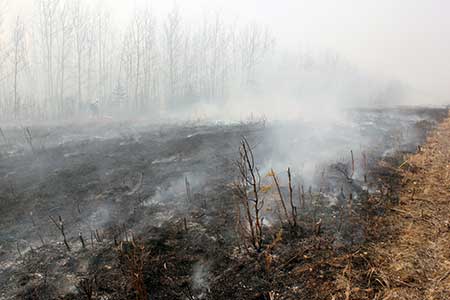
At 67 degrees F, 15% RH, and SE winds at 7-9 mph with gusts to 16, the ignition began. The first panel consisted of 3-6 foot tall aspen and willow with patches of grass. The winds were necessary to help fire move through the leaf litter under the saplings. With little grass to carry the fire, it would not burn independently without repeated ignitions in strips throughout the panel. This meant that a perimeter ignition was insufficient to burn the unit. Only with the help of the White Mountain crew was this operation successful. We needed to apply fire to the ground every 20-40 yards in strips across each panel to create enough heat for fire to continue burning. With two burn bosses at the helm, six firefighters ‘holding’ at the far end of the unit, and 16 firefighters igniting multiple panels at once, we were able to burn 224 acres in the first afternoon.
An additional 66 acres were burned that first day by the local fire departments from Rural Deltana and Ft. Greely as they participated in a wildfire scenario hosted by Mike Goyette, Fire Management Officer for State Forestry in Delta Junction.
As a milestone event, these same firefighters brought fire to the Gerstle Field Complex on Thursday, May 10th. The last use of prescribed fire in this field is unknown as moisture is high and running fire here takes so much effort. Once again, the White Mountain crew and ADF&G staff assessed conditions and determined that weather and fuel conditions were within the burn plan’s set prescription.
At 70 degrees F and 23% relative humidity, the fire was ignited with a 7 mph wind from the south. Initially, this fire behaved similar to the previous day’s burn in the Panoramic field: fire carried well in the grass and slowed in the leaf litter where aspen and willow regeneration dominated the site. Shortly after ignition however, the winds diminished and crews had to work harder to put more fire on the ground. The high moisture common to this site dampened active fire. Only the very top of the litter layer burned, but we observed substantial scorch on the willow. Fall post-fire evaluation of the burn will confirm whether we killed sufficient willow and aspen in all of the fields to achieve the burn’s objectives.
In writing the prescribed fire burn plan objectives, ADF&G program coordinator Sue Rodman consulted with Wildlife Biologist and bison range manager Clint Cooper and Area Biologist Bob Schmidt along with State Forestry’s Mike Goyette. The primary objective is to enhance forage quantity and quality for bison and moose, and habitat quality for grouse. To provide security for bison, we had to improve their horizontal visibility to see predators. This meant that we had to top kill aspen and willow to reduce vegetation height below 1.5 meters. This action requires that the base of these saplings are scorched sufficiently to penetrate the cambium layer and effectively kill the tree. As noted above, the benefit of top killing aspen and willow is that both species regenerate from the base after fire and provide forage for moose. Burning only the top of the litter layer seems to be providing adequate results in terms of regenerating aspen and willow while also allowing native grasses to fill back into these panels. Sharp-tailed and ruffed grouse use all life stages of aspen along with native grasses for their nutritional and brood needs as well. The low and moderate severity burns we have witnessed in the last two years create a mosaic of vegetation response that correlates well to the burn plan objectives to retain adequate organic soil for moisture holding capacity and release of nutrients.
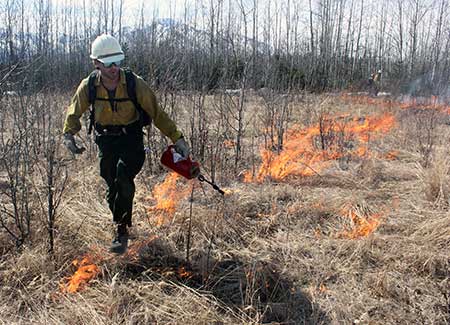
So far, we deem the reintroduction of fire onto the Delta Junction Bison Range a successful endeavor that benefits wildlife and supports the Delta Bison Interim Management Plan. The partnerships that have evolved through this process also create solid relationships at the interagency level for implementing prescribed fire, conducting additional research for wildlife and vegetation response, and build firefighter capacity and expertise for State Forestry. This project is managed through ADF&G’s Wildlife Habitat Enhancement & Spatial Analysis Program in concert with Region III staff from the Delta area office within the Division of Wildlife Conservation.
This year’s operation was paid for through a federal aid grant to enhance wildlife habitat statewide. Once we determine an operational cost to annually run fire in the bison range, we anticipate that prescribed fire can again become a regular part of the bison range management regime.
Sue Rodman is a Program Coordinator and Forester with the Wildlife Habitat Enhancement & Spatial Analysis Program, with the Division of Wildlife Conservation.
Subscribe to be notified about new issues
Receive a monthly notice about new issues and articles.
